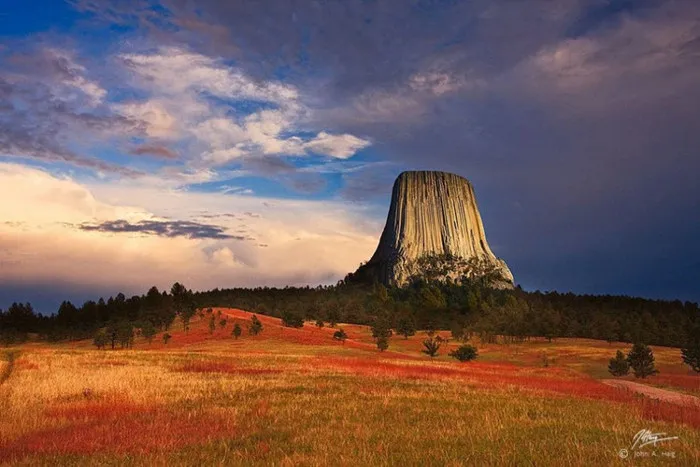Wyoming, a mountainous state in the western United States, is famed for its expansive grasslands and the grand Yellowstone National Park. Yet, hidden within its borders is an extraordinary geological treasure—the captivating red rock regions. Among these, Devils Tower stands tall as an iconic landmark, a testament to the powerful forces of nature over millennia. Exploring Wyoming’s red rocks will take you on a journey through breathtaking landscapes where geological history unfolds in stunning detail, with Devils Tower as the ultimate highlight for passionate adventurers.
Devils Tower – A Monumental Red Rock Marvel in Wyoming’s High Plains
Devils Tower is a colossal monolith towering 386 meters above its surrounding terrain, with an elevation of 1,558 meters above sea level. Located in northeastern Wyoming, this remarkable formation rises dramatically above the open prairies and rolling hills. While it may not exhibit the vibrant red hues characteristic of other global red rock regions, Devils Tower showcases warm tones of sandstone and weathered clay, particularly striking at sunrise or sunset when the light casts a reddish glow. This awe-inspiring marvel, with its unique pillar-like structure, leaves all who witness it wondering about its mysterious origins and formation.
In 1906, President Theodore Roosevelt declared Devils Tower the first National Monument of the United States, recognizing its exceptional natural and cultural significance. Before it was coined “Devils Tower” in 1893 by explorers William Rogers and Willard Ripley, the region had long been regarded as sacred by Native American tribes, steeped in legends and spiritual traditions.
Decoding Geological Secrets – The Formation of Devils Tower
To grasp the wonders of Devils Tower, we must travel back in geological history approximately 65 million years to the Paleogene Period. During this era, present-day Wyoming was an expansive flatland blanketed with sedimentary rock layers. Intense volcanic activity beneath the surface forced molten magma upward. Instead of erupting violently, this magma remained trapped beneath the sedimentary layers, forming a massive intrusive body.
Over millions of years, the surrounding softer sedimentary rocks were eroded by wind, rain, and ice, while the now-cooled and solidified magma resisted erosion much more effectively. These extended erosional processes gradually unveiled the towering basalt columns of Devils Tower, lined with vertical fissures created by the contraction of magma during cooling. This extraordinary structure, featuring stacked vertical columns, stands as a striking testament to the power of Earth’s geological processes.
Though formed by volcanic activity, Devils Tower is not an actual volcano. It is the remnant of an intrusive magma body—a vivid reminder of the enduring interplay between Earth’s constructive and erosive forces over millions of years.
Legends and Native Culture – Devils Tower Through the Lens of Indigenous Tribes
For Native American tribes like the Lakota Sioux, Cheyenne, and Kiowa, Devils Tower is much more than a natural geological formation; it is a sacred site intertwined with profound mythology and cultural traditions. Each tribe has its own narrative of the Tower’s origins, many of which revolve around the iconic image of a giant bear and a “spiritual” rock.

One of the most well-known stories tells of seven young girls from a Native American tribe being chased by a giant bear. As the bear approached, the girls climbed onto a small rock and pleaded for divine help. Miraculously, the rock grew higher, lifting the girls out of the bear’s reach. Enraged, the bear clawed at the rock’s sides, leaving the vertical grooves that characterize Devils Tower. Ultimately, the girls were taken into the heavens, where they became the Pleiades constellation (also known as the Seven Sisters).
This legend not only explains the Tower’s distinctive appearance but also reflects the deep connection between Native Americans and the spiritual and natural elements of their world. Today, Devils Tower remains a sacred site where many tribes continue to perform traditional rituals and prayers.
Exploring Devils Tower Today – A Unique Travel Experience
Devils Tower is now a globally renowned tourist destination, drawing visitors from across the globe to admire its grandeur and uncover its geological mysteries and cultural heritage. The surrounding Devils Tower National Monument preserves the area while providing amenities and diverse activities for travelers.
Rock Climbing: With its vertical columns and unique rock surfaces, Devils Tower is a bucket-list destination for rock-climbers. However, climbing here requires skill and experience, and climbers must adhere to park regulations to ensure safety and environmental conservation.
Hiking and Sightseeing: Multiple hiking trails of varying difficulty encircle the Tower, catering to visitors of all levels. These trails offer stunning vantage points of Devils Tower from different perspectives, while allowing explorers to immerse themselves in the rich flora, fauna, and cultural history of the Wyoming high plains.
Visitor Center: The Devils Tower Visitor Center provides valuable information about the area’s geology, history, culture, and tourism activities. Exhibits, documentaries, and interactive discussions with park staff offer insightful glimpses into the Tower’s intriguing past and present.
Wildlife Observation: The national monument is home to diverse wildlife, including deer, elk, coyotes, and various bird species. Wildlife enthusiasts can observe animals in their natural habitats, especially during early morning or late afternoon hours.
Camping and Stargazing: The monument features campsites for visitors seeking a rustic outdoor experience. At night, the crystal-clear skies above Devils Tower become an ideal setting for stargazing, offering mesmerizing views of the universe.
Conclusion
No exploration of Wyoming’s red rock regions would be complete without a visit to Devils Tower—a unique and mysterious natural wonder. From its puzzling geology and mesmerizing structure to its legendary tales and cultural significance, Devils Tower offers visitors an unforgettable journey of discovery and awe. By venturing to Devils Tower, you’ll not only marvel at the raw beauty of nature but also delve deep into millions of years of geological history, immerse yourself in Native American heritage, and enjoy a range of activities amid Wyoming’s vast landscapes. Let Devils Tower be a cornerstone of your adventure through Wyoming’s majestic red rocks.